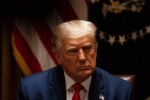Behind Trump Tariffs Is Capital’s Warfare Against the Working Class
What is behind the tariff war that Donald Trump has launched against Mexico, Canada and China, with a promise to extend the war to the world as a whole? Moving beyond the smoke and mirrors, we must step back and focus on three things. First, the tariff war is a response to the rapidly deepening crisis of global capitalism. Second, it is one component of a radical escalation of class warfare from above against the U.S. and the global working class. And third, the tariff policy is riddled with so many contradictions that it will end up aggravating the crisis and contributing to the unraveling of the Trump coalition.
The crisis of global capitalism is both economic and political. Economically, the system faces a structural crisis of overaccumulation and chronic stagnation that generates turbulence in global financial markets as it heightens international and geopolitical conflict. Over the past half-century, every country has become integrated into a global system of production, finance and services. Nationalist and populist movements of both the left and the right may wish to extricate their countries from this global economy, but withdrawal is impossible — or at least not possible without massive disruption that would generate chaos and collapse. The 2020 COVID-19 shutdown that interrupted global supply chains, for instance, triggered an economic meltdown and social catastrophe unmatched since the Great Depression of the 1930s.
Trump’s tariff war will aggravate the economic turbulence, but the system also faces a spiraling political crisis of state legitimacy, capitalist hegemony and mass social discontent. These political dimensions of the crisis reflect a fundamental contradiction in the organization of global capitalism: the disjuncture between a globally integrated economy and a nation-state-based system of political authority. Despite our economic interdependence, political authority is divided up among over 200 individual nation-states. These capitalist states have a contradictory mandate. On the one hand, each individual state needs to achieve political legitimacy among its respective population and stabilize its own national social order. On the other hand, it must promote transnational capital accumulation in its territory in competition with other states and secure the inflow of resources and raw materials that this capital needs.
The transnational capitalist class (TCC) is not tethered to particular nation-states. Its members will welcome any incentive offered by a state if it enhances profit-making opportunities and will invest wherever they find the best conditions to accumulate. As the crisis has deepened, each state seeks to reduce risks to its internal economy in the face of global financial turmoil and political instability by doubling down on policies that incentivize or oblige transnational corporations to invest in its domestic economy.
These two functions of the capitalist state — the accumulation function and the legitimation function — are incompatible with one another and are played out in protectionist wars and other forms of interstate competition. Attracting transnational investment requires providing capital with incentives such as low wages and labor discipline, a lax regulatory environment, tax concessions, investment subsidies, privatization, deregulation, and so on — precisely the neoliberal policies that have been pursued worldwide since the onset of globalization. The result is rising inequality, impoverishment and insecurity for working and popular classes — precisely the conditions that throw states into crises of legitimacy, destabilize national political systems, jeopardize elite control and give impetus to the rise of a neofascist right.
This is the larger context for the rise of Trumpism, which must be seen as a far right, neofascist response to the social and economic crisis of the U.S. working class and to the crisis of state legitimacy that it has produced. The working class has experienced an ongoing destabilization of its living conditions over this past half-century, with a particularly sharp deterioration since the financial collapse of 2008 and in the wake of the COVID-19 pandemic. It faces increasing precarity, job instability, widespread and rising un- and underemployment, poverty wages, marginalization and social decomposition, food insecurity, and crises of health care, substandard housing and homelessness.
Trump managed to get elected for a second term through a populist, nationalist, racist and neofascist discourse that spoke to this rising socioeconomic insecurity and mass social anxiety. He manipulated mass discontent with the Democratic Party and with the status quo, above all with a false promise to solve the socioeconomic problems of the masses. Hypernationalism has always been a key ideological weapon of the ruling classes to channel mass disaffection away from its source in the system, especially during times of crisis and rising class struggle, and toward scapegoated groups such as immigrants and “foreign enemies.”
Far from stabilizing global capitalism, the Trump project will........






















 Toi Staff
Toi Staff Tarik Cyril Amar
Tarik Cyril Amar Andrew Mitrovica
Andrew Mitrovica Sharona Margolin Halickman
Sharona Margolin Halickman Rachel Marsden
Rachel Marsden Patrick Gathara
Patrick Gathara Belen Fernandez
Belen Fernandez Gideon Levy
Gideon Levy Alexey Kupriyanov
Alexey Kupriyanov
